- HOME
- MINDSET
- T-SHIRTS
- JUST4KEEPERS GOALKEEPER TRAINING
- UNDERSTANDING GOALKEEPING
- LAWS of SOCCER
- Law 1: The Playing Field (Pitch)
- Law 2: The Ball
- Law 3: The Number of Players
- Law 4: The Player's Equipment
- Law 5: The Referee
- Law 6: Assistant Referee
- Law 7: The Duration of the Match
- Law 8: The Start and Stop of Play
- Law 9: Ball in and out of Play
- Law 10: The Method of Scoring
- Law 11: The Offside
- Law 12: Fouls and Misconduct
- Law 13: Free Kicks
- Law 14: Penalty Kicks
- Law: The Throw In
- Law 16: The Goal Kick
- Law 17: The Corner Kick
- FIFA
- WOMEN'S SOCCER
- 2014 WORLD CUP
- 2010 WORLD CUP FINAL
- LIVE SCORES and LEAGUE STATISTICS
- BLOG
- USING UNDERSTANDING SOCCER
- MLS
- WNSL
- LEAGUE PLAY
- ANATOMY OF A GAME
- SOME BACKGROUND
- OFFENSE
- DEFENSE
- YOUTH SOCCER
- HISTORY OF SOCCER
- GEORGE VECSEY
- REGIONAL & INTERNATIONAL PLAY
- SOCCER TERMINOLOGY
- BOOKS / REFERENCES
- FEEDBACK / QUESTIONS
- SOME PERSPECTIVES
- PHOTO GALLARY
- FORUM
- BREAKAWAY VIDEO
- USA SOCCER
- JEN'S MOTH
Soccer Ball Dimentions

Throughout time, the rules for soccer regarding the ball has remained basically the same. The soccer ball must have a circumference between 68 and 70 centimeters and a weight between 410 and 450 grams, but the rules also state that the ball can be made out of "leather or any similar material".
Well that "any similar material" bit constantly improved over time and nowadays soccer balls have reached near-perfection. Almost every World Cup brought a new type of soccer ball, with improved characteristics, although all of them stayed inside the official soccer rules.
Well that "any similar material" bit constantly improved over time and nowadays soccer balls have reached near-perfection. Almost every World Cup brought a new type of soccer ball, with improved characteristics, although all of them stayed inside the official soccer rules.
Official 2010 World Cup Ball
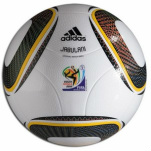
Adidas' 11th FIFA World Cup official match ball. Designed for never before seen power, swerve and control. The cover is a termally-bonded PU for exceptionally true and straight flight. The bladder is a latex for excellent rebound. FIFA approved.
Goalies disliked the ball as it took off on them. See explanation under "Official 2014 World Cup Ball" .
Goalies disliked the ball as it took off on them. See explanation under "Official 2014 World Cup Ball" .
Official 2014 World Cup Ball
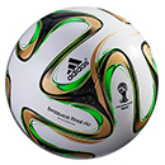
After a controversial ball design for the 2010 World Cup, adidas' 2014 creation, the Brazuca ball, is better suited for Brazil's climate according to researchers.
Players during the World Cup in South Africa complained about the makeup of the Jabulani, the ball specifically designed for the 2010 matches.
Each ball has a distinct speed that once hit, the path will no longer be predictable, even to the most seasoned player.
According to Adrian Kiratidis, Ph.D. candidate at the University of Adelaide in Australia, once the Jabulani reached a speed between 55 and 70 kph (34 and 43 mph), players would not have been able to determine the direction the ball would travel.
"This is why the complaints about 'beach ball' behavior were justified," said Kiratidis.
The Brazuca, the new ball, gives more reaction time as it loses control near the 35-55 kph (21-34 mph) range.
Altitude and temperature are other factors that can have an impact on a ball.
"Altitude is key from our point of view, as it changes the air density," said Derek Leinweber, a professor at the University of Adelaide. "It will affect the amount a spinning kick will bend, the final speed of the ball and the associated time to the net."
Stadiums for the 2014 World Cup are at a much lower altitude than those in South Africa. Leinweber explained that the air density will drop by 10 percent when traveling from one of the venues at sea level to Estadio Nacional in Brasilia, the venue with the highest elevation of 1,172 m (3,845 feet).
This means that the ball has a lesser chance of swerving unreliably.
The ball will also be affected by Brazil's warmth
Players during the World Cup in South Africa complained about the makeup of the Jabulani, the ball specifically designed for the 2010 matches.
Each ball has a distinct speed that once hit, the path will no longer be predictable, even to the most seasoned player.
According to Adrian Kiratidis, Ph.D. candidate at the University of Adelaide in Australia, once the Jabulani reached a speed between 55 and 70 kph (34 and 43 mph), players would not have been able to determine the direction the ball would travel.
"This is why the complaints about 'beach ball' behavior were justified," said Kiratidis.
The Brazuca, the new ball, gives more reaction time as it loses control near the 35-55 kph (21-34 mph) range.
Altitude and temperature are other factors that can have an impact on a ball.
"Altitude is key from our point of view, as it changes the air density," said Derek Leinweber, a professor at the University of Adelaide. "It will affect the amount a spinning kick will bend, the final speed of the ball and the associated time to the net."
Stadiums for the 2014 World Cup are at a much lower altitude than those in South Africa. Leinweber explained that the air density will drop by 10 percent when traveling from one of the venues at sea level to Estadio Nacional in Brasilia, the venue with the highest elevation of 1,172 m (3,845 feet).
This means that the ball has a lesser chance of swerving unreliably.
The ball will also be affected by Brazil's warmth
Early Ball History
Through out history, humans have enjoyed kicking a ball or something like a ball. South American Indians were known to use a light elasticized ball. However; rubber was practically manufactured until a few thousand years later.
According to historical references and legend, early balls ranged from human heads, stitched up cloth, animal and human skulls to pig or cow bladders.
During the Ts'in and Han Dynasties (255 BC-220 AD), the Chinese played 'tsu chu', in which animal-skin balls were dribbled through gaps in a net stretched between two poles. Certain ancient Egyptian rites are said by historians to have similarities with football, and both the ancient Greeks and Romans also played a game that entailed carrying and kicking a ball.
According to pre-medieval legend, an entire village would kick a skull along a path to a nearby village square. The opposing village would in turn attempt to kick the skull to the first village's square. Wow, that probably caused more riots than in modern soccer games.
A Medieval custom was to take pig bladders used from live stock killed in preparation for winter sustenance and inflate them. They would play a game using their feet and hands to keep the "ball" in the air.
The animal bladder balls were eventually covered with leather for better shape retention.
According to historical references and legend, early balls ranged from human heads, stitched up cloth, animal and human skulls to pig or cow bladders.
During the Ts'in and Han Dynasties (255 BC-220 AD), the Chinese played 'tsu chu', in which animal-skin balls were dribbled through gaps in a net stretched between two poles. Certain ancient Egyptian rites are said by historians to have similarities with football, and both the ancient Greeks and Romans also played a game that entailed carrying and kicking a ball.
According to pre-medieval legend, an entire village would kick a skull along a path to a nearby village square. The opposing village would in turn attempt to kick the skull to the first village's square. Wow, that probably caused more riots than in modern soccer games.
A Medieval custom was to take pig bladders used from live stock killed in preparation for winter sustenance and inflate them. They would play a game using their feet and hands to keep the "ball" in the air.
The animal bladder balls were eventually covered with leather for better shape retention.
Beginning of The Modern Ball
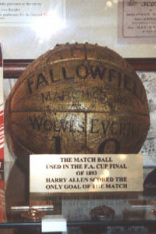
In 1836 Charles Goodyear patented vulcanized rubber. Prior to this, balls were dependant on the size and shape of the pig's bladder. The more irregular the bladder, the more unpredictable the behavior of the ball was when kicked. However; it would not be until the twentieth century that most balls were made with rubber bladders.
Match Ball used in the FA Cup Final of 1893
Wolves 1 Everton 0
In 1855, Charles Goodyear designed and built the first vulcanized rubber soccer balls (footballs), one of which is on display at the National Soccer Hall of Fame which is located in Oneonta, NY, USA.
In the 1862, H.J. Lindon developed one of the first inflatable rubber bladders for balls. Tragically his wife previously died from lung disease, reportedly from blowing up many hundreds of pig's bladders. Lindon was probably inspired to develop the inflatable rubber bladder because of the ill effects of blowing up pig's bladders. The balls with the rubber bladders ensured that the ball remained hard and true. Lindon also claimed to have invented the rugby ball but did not patent the idea. In those days, the round ball was preferred because it was easier to kick and the oval ball was easier to handle.
In 1863 the newly formed English Football Association met to hammer out the laws of the game. No description of the ball was offered in the first set of rules. When the rules were revised in 1872 it was agreed that the ball "must be spherical with a circumference of 27 to 28 inches" (68.6 cm to 71.1 cm). That rule remains in today's FIFA laws. Very little has ever been written about the ball, probably because it has remained very much the same over the years. The official size and weight of the ball was first fixed in 1872. It was changed ever so little in 1937 when the official weight was increased from 13-15 oz to 14-16 oz. The Encyclopedia of Association Football (first published in England in 1956) says as follows "According to the Laws of Football, the ball must be spherical with an outer casing of leather or other approved materials. The circumference shall not be more than 28 in., nor less than 27 in, while the weight at the start of the game must not be more that 16 oz., nor less than 14 oz." The Laws of the Game as published in 2001 say exactly the same thing as to size and weight. What has changed drastically over the last 30 or so years is the material the ball is made of and the shape of the panels that make up the ball.
Mass production of soccer balls started as a direct consequence of the English Football League that was founded in 1888. Mitre and Thomlinson's of Glasgow were two of the first companies to mass produce soccer balls during that time. They touted that the key element in a quality football was how well it could retain it's shape. Strength of the leather and the skills of the cutters and stitchers were the main factors in producing a football that would retain it's shape. The top grade covers were made with leather from the rump of a cow while lower quality balls were made from the shoulder. Advances in ball design came with the development of interlocking panels instead of the previously used leather sections that met at the north and south poles of the ball. The balls were then produced with a more acceptable round shape.
Match Ball used in the FA Cup Final of 1893
Wolves 1 Everton 0
In 1855, Charles Goodyear designed and built the first vulcanized rubber soccer balls (footballs), one of which is on display at the National Soccer Hall of Fame which is located in Oneonta, NY, USA.
In the 1862, H.J. Lindon developed one of the first inflatable rubber bladders for balls. Tragically his wife previously died from lung disease, reportedly from blowing up many hundreds of pig's bladders. Lindon was probably inspired to develop the inflatable rubber bladder because of the ill effects of blowing up pig's bladders. The balls with the rubber bladders ensured that the ball remained hard and true. Lindon also claimed to have invented the rugby ball but did not patent the idea. In those days, the round ball was preferred because it was easier to kick and the oval ball was easier to handle.
In 1863 the newly formed English Football Association met to hammer out the laws of the game. No description of the ball was offered in the first set of rules. When the rules were revised in 1872 it was agreed that the ball "must be spherical with a circumference of 27 to 28 inches" (68.6 cm to 71.1 cm). That rule remains in today's FIFA laws. Very little has ever been written about the ball, probably because it has remained very much the same over the years. The official size and weight of the ball was first fixed in 1872. It was changed ever so little in 1937 when the official weight was increased from 13-15 oz to 14-16 oz. The Encyclopedia of Association Football (first published in England in 1956) says as follows "According to the Laws of Football, the ball must be spherical with an outer casing of leather or other approved materials. The circumference shall not be more than 28 in., nor less than 27 in, while the weight at the start of the game must not be more that 16 oz., nor less than 14 oz." The Laws of the Game as published in 2001 say exactly the same thing as to size and weight. What has changed drastically over the last 30 or so years is the material the ball is made of and the shape of the panels that make up the ball.
Mass production of soccer balls started as a direct consequence of the English Football League that was founded in 1888. Mitre and Thomlinson's of Glasgow were two of the first companies to mass produce soccer balls during that time. They touted that the key element in a quality football was how well it could retain it's shape. Strength of the leather and the skills of the cutters and stitchers were the main factors in producing a football that would retain it's shape. The top grade covers were made with leather from the rump of a cow while lower quality balls were made from the shoulder. Advances in ball design came with the development of interlocking panels instead of the previously used leather sections that met at the north and south poles of the ball. The balls were then produced with a more acceptable round shape.
1930 World Cup Soccer Ball: Uruguay 4-Argentina 2
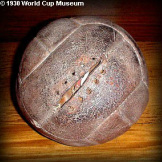
1930 World Cup Soccer Ball of "Tiento"
One of the two soccer balls used in the first 1930 World Cup final between Argentina and Uruguay is shown above. This leather football was used in the final match and taken by an Uruguayan team player. It may have even played a part in the outcome of the first world cup in 1930. Argentina and Uruguay could not agree on which ball to use. So they decided to use an Argentinean ball the first half and a ball supplied by Uruguay the second half. As it turned out, Argentina was ahead at halftime 2-1. However; Uruguay came back to win the match in the second half 4-2 using their ball!
One of the two soccer balls used in the first 1930 World Cup final between Argentina and Uruguay is shown above. This leather football was used in the final match and taken by an Uruguayan team player. It may have even played a part in the outcome of the first world cup in 1930. Argentina and Uruguay could not agree on which ball to use. So they decided to use an Argentinean ball the first half and a ball supplied by Uruguay the second half. As it turned out, Argentina was ahead at halftime 2-1. However; Uruguay came back to win the match in the second half 4-2 using their ball!
1030's Ball
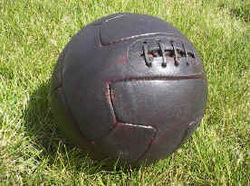
By the 1900's bladders were made with stronger rubber and could withstand heavier pressure. Most balls produced by that time used rubber bladders. The balls were made from inner tubes covered with heavy brown leather. These balls would bounce easier and yet could be kicked. Most balls had a tanned leather cover with eighteen sections stitched together arranged in six panels of three strips each. Each section was stitched together by hand with five-ply hemp and a small lace-up slit was on one side. All of the stitching was done with the ball cover inside out. Once completed, the cover was reversed with the stitching on the inside. An un-inflated bladder was then inserted through the slit. A long stem neck (aperture) extending from the bladder was used to inflate the ball. Once inflated, the tube was inserted through the 15 cm slit and then the opening was laced up tight. You can imagine how often that these soccer balls had to re-inflated. Even during a game.
These balls were good for kicking but was painful when heading due to the heavy stitching and the water absorption characteristics of the leather. Water absorption of the leather during rain made the ball very heavy and caused many head injuries. Other problems of the old leather balls were the various quality of cowhides used. Footballs varied in thickness and quality and the leather often degraded during the match.
These balls were good for kicking but was painful when heading due to the heavy stitching and the water absorption characteristics of the leather. Water absorption of the leather during rain made the ball very heavy and caused many head injuries. Other problems of the old leather balls were the various quality of cowhides used. Footballs varied in thickness and quality and the leather often degraded during the match.
1950 Era 18 Panel Ball
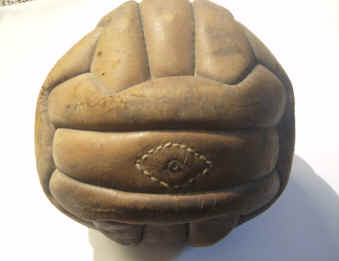
The ball had a smoother appearance when fully pumped.
In 1951 a white ball was first permitted to help spectators see the ball easier with the advent of floodlights. White soccer balls were un-officially used as early as 1892. The leather was simply white washed to produce the white ball. Orange balls were also first introduced in the 1950's to help see the ball in the snow.
Different countries favored different types of soccer balls in the early days of international soccer. This caused much controversy. FIFA standardized the size, weight and type of balls with the introduction of an international board.
In 1951 a white ball was first permitted to help spectators see the ball easier with the advent of floodlights. White soccer balls were un-officially used as early as 1892. The leather was simply white washed to produce the white ball. Orange balls were also first introduced in the 1950's to help see the ball in the snow.
Different countries favored different types of soccer balls in the early days of international soccer. This caused much controversy. FIFA standardized the size, weight and type of balls with the introduction of an international board.